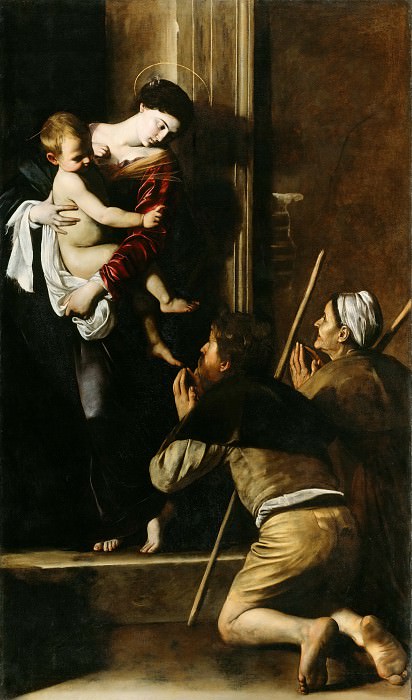Madonna of the Pilgrims Michelangelo Merisi da Caravaggio (1571-1610)
Michelangelo Merisi da Caravaggio – Madonna of the Pilgrims
Edit attribution
Download full size: 2471×4200 px (2,7 Mb)
Painter: Michelangelo Merisi da Caravaggio
The painting was commissioned by the aristocratic Cavaletti family as an altarpiece for the family church chapel at Sant’Agostino in Rome. The painting was painted in two stages with a pause due to a conflict with a notary who objected to having the image of Mary posed by the master’s lover. After a time, the artist returned to his monumental work and completed it. The Virgin Mary on this canvas seems to be floating in the heavens in the middle of the altar space.
Description of Merisi da Caravaggio’s Madonna di Loreto (1604-1606)
The painting was commissioned by the aristocratic Cavaletti family as an altarpiece for the family church chapel at Sant’Agostino in Rome. The painting was painted in two stages with a pause due to a conflict with a notary who objected to having the image of Mary posed by the master’s lover. After a time, the artist returned to his monumental work and completed it.
The Virgin Mary on this canvas seems to be floating in the heavens in the middle of the altar space. The painter dared to show her in the guise of an ordinary peasant woman at the moment of a touching, humble and warning meeting with two barefooted pilgrims, soiled during the long road. It is not in vain that the second title of the painting is Our Lady of the Pilgrims. The Madonna’s face is full of boundless chastity and artlessness. Baby Jesus in her arms is looking at the pilgrims with inquisitiveness and concern.
The master paid great attention to detail, focusing on the large size of the child and the depiction of Mary’s weightless feet. However, for a divine character, her pose is very coquettish and immodest. She is dressed in a dusky garment, a dark blue chiton of silk, and on top an olive-brown velvety blouse that hides her arms, but reveals her neck and part of her chest too boldly for a biblical scenario.
The images of the pilgrims on the canvas are purely striking. In the foreground of the painting are expressive figures of pilgrims equipped with long staffs. They look like ordinary peasants, judging by their attire. They greet the Child and His mother on their knees, with their hands respectfully folded in prayer. What catches the eye is the woman’s dirty headdress and the artist’s highlighting of the soiled feet of the young commoner who has traveled the difficult path barefoot. The feet almost reach the edge of the canvas.
Caravaggio first expressed on the canvas the idea of the injustice of the existence on earth order, which even the divine forces are unable to change. "Madonna of Loreto" did not interest connoisseurs, who found it inexpressive, but it was admired by the common people who offered prayers in front of it. The true essence of the painting lies in the author’s idea that pilgrimage is a metaphor for worldly life, as well as in the immutable importance of spirituality.
Кому понравилось
Пожалуйста, подождите
На эту операцию может потребоваться несколько секунд.
Информация появится в новом окне,
если открытие новых окон не запрещено в настройках вашего браузера.
You need to login
Для работы с коллекциями – пожалуйста, войдите в аккаунт (open in new window).




















You cannot comment Why?
Before them kneel two pilgrims. The man in the foreground is on his hands and knees, his head bowed in adoration, his hands clasped in prayer. He wears simple, earth-toned clothing and carries a walking stick, suggesting his journey. Behind him, an elderly woman also kneels with her hands clasped, her face turned upward as she gazes at the divine figures. She too is dressed in humble attire and is accompanied by a walking stick.
The setting appears to be a darkened architectural space, possibly a doorway or entryway, with a column to the right and a suggestion of a ledge or step in the foreground. The use of chiaroscuro, the strong contrast between light and dark, dramatically highlights the figures and creates a sense of intimacy and divine presence, drawing the viewers focus to the devotional act.
The subtexts of the painting revolve around themes of faith, humility, and divine grace. The title, Madonna of the Pilgrims, directly points to the focus on the journey of faith. The pilgrims, depicted in their worn clothes and with their walking sticks, represent ordinary people undertaking a spiritual quest. Their humble posture and genuine devotion convey intense faith and a plea for divine intercession. The infant Jesus, with his active gesture of reaching down, symbolizes his compassion and willingness to engage with humanity. Marys gentle gaze suggests her role as a merciful intercessor.
The painting, through its naturalistic depiction of humble figures and its dramatic lighting, emphasizes the accessibility of the divine to even the most ordinary individuals. It suggests that faith and devotion are the keys to experiencing Gods grace, regardless of ones social standing or worldly possessions. The intimate and powerful portrayal of this encounter invites viewers to reflect on their own faith journeys and their relationship with the divine.